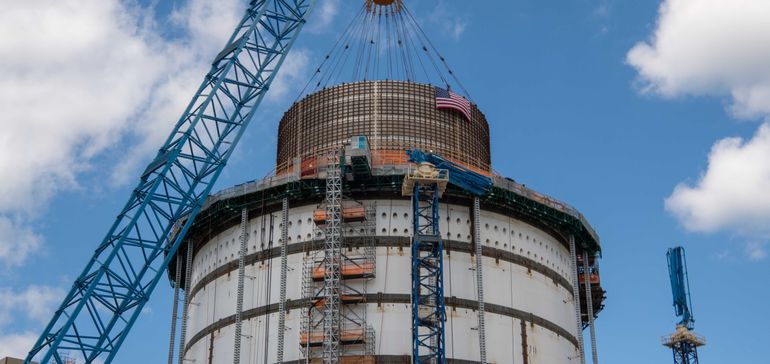Small modular reactors will not save the day. The US can get to 100% clean power without new nuclear.
The following is a contributed article by Arjun Makhijani, president of the Institute for Energy and Environmental Research.
There is a widespread view that nuclear energy is necessary for decarbonizing the electricity sector in the United States. It is expressed not only by the nuclear industry, but also by scholars and policy-makers like former Energy Secretary Steven Chu, a Nobel Prize-winning physicist who recently said that the choices we have “…when the wind doesn’t blow and the sun doesn’t shine” are “fossil fuel or nuclear.” I disagree
Wind and solar are much cheaper than new nuclear plants even when storage is added. The National Renewable Energy Laboratory estimated the cost of unsubsidized utility-scale solar plus battery storage in 2021 was $77 per megawatt-hour — about half the cost of new nuclear as estimated by the Wall Street firm Lazard. (An average New York State household uses a megawatt-hour in about seven weeks.)
Time is the scarcest resource of all for addressing the climate crisis. Nuclear has failed spectacularly on this count as well. Of the 34 new reactor projects announced for the “nuclear renaissance,” only two reactors being built in Georgia are set to come online — years late at more than double the initial cost estimate, a success rate of 6%. Even including the old Watts Bar 2 reactor (start of construction: 1973), which was completed in 2016 (well over budget), raises the success rate to just 9% — still much worse than the mediocre 50-50 record of the first round of nuclear construction in the US, when about half of the proposed reactors were ultimately built. The nuclear industry is marching fast — in the wrong direction.
The much-ballyhooed Small Modular Reactors are not going to save the day. NuScale, the most advanced in terms of certification, had announced in 2008 that its first reactor would be on line in 2015-2016; now the date is 2028 and costs have risen. In the same period, wind and solar generation have cumulatively generated electricity equal to more than the amount 300 NuScale SMRs would produce in 15 years. Nuclear is dismally slow, unequal to the climate challenge.
Simply saying that nuclear is “baseload power” is to recite an obsolete mantra. As David Olsen, a member of the Board of Governors of the California Independent System Operator, which runs that state’s electricity grid, has said: “’Baseload’ refers to an old paradigm that has to go away.”
It is generally agreed that solar, wind and battery storage cannot address the entire decarbonization problem. They can do the job economically and reliably about 95% of the time. Much of the gap would be on winter nights with low wind when most buildings have electrified their heating and electric cars are plugged in. That’s where working with the rhythms of nature comes in.
Spring and autumn will be times of plentiful surplus wind and solar; that essentially free electricity could be used to make hydrogen to power light-duty fuel cells (such as those used in cars) to generate electricity on those cold winter nights. Surplus electricity can also be stored in the ground as cold or heat — artificial geothermal energy — for use during peak summer and winter hours.
Then there is V2G: vehicle-to-grid technology. When Hurricane Ian caused a blackout for millions in Florida, a Ford F-150 Lightning in “vehicle-to-home” mode saved the day for some. Plugged-in cars could have a dual purpose — as a load on the grid, or, for owners who sign up to profit, a supply resource for the grid, even as the charge for the commute next day is safeguarded.
We are also entering an era of smart appliances that can “talk” to the grid; it’s called “demand response.” The Federal Energy Regulatory Commission recognizes it as a resource equivalent to generation when many devices like cars or air conditioners are aggregated. People would get paid to sign up, and on those rare occasions when their heaters are lowered a degree or their clothes washing is postponed by a few hours, they would be paid again. No one would have to sign up; but signing up would make electricity cheaper. We know from experience there will be plenty of takers if the price is right.
All that is more than enough to take care of the 5% gap. No uranium mining, no nuclear waste, no plutonium produced just to keep the lights on.
We can create a renewable electricity system that is much more resilient to weather extremes and more reliable than what we have today. The thinking needs to change, as the Drake Landing Solar Community in Alberta, Canada, where it gets to negative 40 degrees Celsius in the winter, has shown. It provides over 90% of its heating by storing solar energy in the ground before the winter comes. Better than waiting for the nuclear Godot.



Comments are closed.